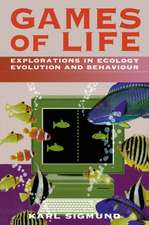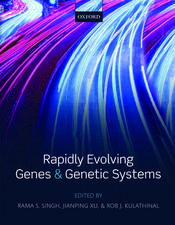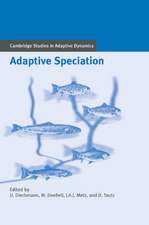Cultural Phylogenetics: Concepts and Applications in Archaeology: Interdisciplinary Evolution Research, cartea 4
Editat de Larissa Mendoza Straffonen Limba Engleză Hardback – 19 feb 2016
The volume is divided into two parts: The first covers the theoretical and conceptual implications of using evolution-based models in the sociocultural domain, illustrates the sorts of questions that these methods can help answer, and invites the reader to reflect on the opportunities and limitations of these perspectives. The second part comprises case studies that address relevant empirical issues, such as inferring patterns and rates of cultural transmission, detecting selective pressures in cultural evolution, and explaining the nature of cultural variation.
This book will appeal to archaeologists interested in applying evolutionary thinking and inferential methods to their field, and to anyone interested in cultural evolution studies.
| Toate formatele și edițiile | Preț | Express |
|---|---|---|
| Paperback (1) | 827.70 lei 38-44 zile | |
| Springer International Publishing – 30 mar 2018 | 827.70 lei 38-44 zile | |
| Hardback (1) | 836.36 lei 38-44 zile | |
| Springer International Publishing – 19 feb 2016 | 836.36 lei 38-44 zile |
Preț: 836.36 lei
Preț vechi: 1100.47 lei
-24% Nou
Puncte Express: 1255
Preț estimativ în valută:
160.09€ • 173.95$ • 134.56£
160.09€ • 173.95$ • 134.56£
Carte tipărită la comandă
Livrare economică 16-22 aprilie
Preluare comenzi: 021 569.72.76
Specificații
ISBN-13: 9783319259260
ISBN-10: 3319259261
Pagini: 202
Ilustrații: XII, 202 p. 55 illus., 28 illus. in color.
Dimensiuni: 155 x 235 mm
Ediția:1st ed. 2016
Editura: Springer International Publishing
Colecția Springer
Seria Interdisciplinary Evolution Research
Locul publicării:Cham, Switzerland
ISBN-10: 3319259261
Pagini: 202
Ilustrații: XII, 202 p. 55 illus., 28 illus. in color.
Dimensiuni: 155 x 235 mm
Ediția:1st ed. 2016
Editura: Springer International Publishing
Colecția Springer
Seria Interdisciplinary Evolution Research
Locul publicării:Cham, Switzerland
Public țintă
ResearchCuprins
Intro: The use of cultural phylogenetics in archaeological and anthropological research. Author 1: Larissa Mendoza Straffon Contact: l.mendoza@hum.leidenuniv.nl Part I: Conceptualizing Cultural Evolution: Units, Levels and Mechanisms 1.Development and degeneration: Classification and evolution of human populations and languages in the history of anthropology. Author 1: Matthis Krischel Affiliation: Aachen University Author 2: Frank Kressing Affiliation: Ulm University Contact: frank.kressing@uni-ulm.de 2. An epistemological analysis of tree and network thinking in the sociocultural sciences. Author 1: Nathalie Gontier Affiliation: University of Lisbon Contact: nlgontier@fc.ul.pt 3. What are the implications of a Lamarckian component for the evolution of material culture? Author 1: Eugenio Bortolini Affiliation: Department of Biological, Geological and Environmental Sciences, University of Bologna Enrico Crema Contact: e.bortolini@ucl.ac.uk Author 2: Enrico Crema Affiliation: The Institute of Archaeology, UCL Author 3: Mark Lake Affiliation: The Institute of Archaeology, UCL 4.Interdemic selection, social hierarchy, and the cascade effect in cultural evolution: an approach from archaeology. Author 1: Daniel García Rivero Affiliation: Department of Prehistory and Archaeology, University of Seville Contact: garciarivero@us.es 5. A developmental approach to ancient innovation: the potter’s wheel in the Bronze Age east Mediterranean. Author 1: Carl Knappett Affiliation: University of Toronto Contact:carl.knappett@utoronto.ca Author 2: Sander van der Leeuw Affiliation: Arizona State University 6.The importance of a “quantitative genetic” approach to the evolution of artefact morphological traits Author 1: Stephen J. Lycett Affiliation: University at Buffalo, SUNY Contact: S.J.Lycett@kent.ac.uk Part II: Tree and Network-based Phylogenetic Models in Archeology and Anthropology 7. Family resemblances in shell faces: A 2-mode network study of homogeneity and diversityin Caribbean, late pre-colonial material culture. Author 1: Angus A. A. Mol Affiliation: Leiden University Contact: a.mol@arch.leidenuniv.nl 8.Mosaic evolution in cultural frameworks: skateboard decks and projectile points. Author 1: Anna Marie Prentiss Affiliation: Department of Anthropology, The University of Montana, Missoula Contact: anna.prentiss@mso.umt.edu Author 2: Matthew J. Walsh Affiliation: Department of Anthropology, The University of Montana, Missoula Author 3: Randall R. Skelton Affiliation: Department of Anthropology, The University of Montana, Missoula Author 4: Matt Mattes Affiliation: Department of Anthropology, The University of Montana, Missoula 9. Phylogenetic network analysis in material culture: evolution of the Baltic psaltery.Author 1: Ilya Tëmkin Affiliation: Northern Virginia Community College Contact: ilya_temkin@hotmail.com Author 2: Alexey Kossykh Affiliation: European University, St. Petersburg Author 3: Tomas Veloz Affiliation: University of British Columbia 10. Tracking cultural evolution with cladistics: the medicinal use of invertebrates in Northern Vietnam. Author 1:Marianna Teräväinen Affiliation: University of Helsinki, Finland Contact: marianna.teravainen@helsinki.fi 11. Patagonian hunter-gatherers’ networks: linking rock art sites. Author 1: Ines Caridi Affiliation: Instituto de Cálculo, Facultad de Ciencias Exactas y Naturales, Universidad de Buenos Aires, CONICET Author 2: Vivian Scheinsohn Affiliation: Instituto Nacional de Antropología y Pensamiento Latinoamericano(INAPL)/CONICET- Universidad de Buenos Aires Contact: scheinso@retina.ar 12.Reviewing phylogenetics in archaeology with a new study on the Russian “Venus” figurines. Author 1:Allison Tripp Affiliation: University of Victoria Contact: allisonjtripp@gmail.com Author 2: Rutger Jansma Affiliation: University of Minessota
Recenzii
“Larissa Mendoza Straffon’s volume is a timely and welcome addition to the Interdisciplinary Evolution Research series … . This state of affairs makes Mendoza Straffon’s volume path-breaking and of great value in calling attention to and then applying phylogenetic methods in a variety of settings in archeology. … a volume that others can use to inspire their own phylogenetic investigations in archeology.” (Mark Pagel, The Quarterly Review of Biology, Vol. 92 (4), December, 2017)
“Cultural Phylogenetics: Concepts and Applications in Archaeology … assembles seven articles dealing both theoretically and practically with the prospects and challenges of phylogenetic methods in archaeology. … I consider the book to be an interesting contribution, worth being read by everyone who is interested in quantitative methods applied to historical sciences.” (Johann-Mattis List, Systematic Biology, September, 2016)Notă biografică
Larissa Mendoza Straffon is an archaeologist and art scholar. She holds a PhD from the Leiden University Centre for the Arts in Society, in The Netherlands. Her research focuses on the relationship between visual art and human evolution, and prehistoric art traditions. She is a specialist in the Archaic Great Mural rock art tradition of Baja California, Mexico, the development of art in the European Paleolithic, and World Art History. Her fieldwork experience includes important archaeological sites such as the cave of Hohle Fels, in Germany, and the UNESCO-listed Mexican sites of Teotihuacán and Sierra de San Francisco. Mendoza Straffon is an active member of the Mexican Rock Art Association and the Dutch Postgraduate School for Art History. She has held appointments at the Escuela Nacional de Antropología e Historia, in Mexico; the Art History Department of Leiden University, in The Netherlands; Leiden University College The Hague; and the Applied Evolutionary Epistemology Lab at the Centre for Philosophy of Science, in the University of Lisbon, Portugal.
Textul de pe ultima copertă
This book explores the potential and challenges of implementing evolutionary phylogenetic methods in archaeological research, by discussing key concepts and presenting concrete applications of these approaches.
The volume is divided into two parts: The first covers the theoretical and conceptual implications of using evolution-based models in the sociocultural domain, illustrates the sorts of questions that these methods can help answer, and invites the reader to reflect on the opportunities and limitations of these perspectives. The second part comprises case studies that address relevant empirical issues, such as inferring patterns and rates of cultural transmission, detecting selective pressures in cultural evolution, and explaining the nature of cultural variation.
This book will appeal to archaeologists interested in applying evolutionary thinking and inferential methods to their field, and to anyone interested in cultural evolution studies.
The volume is divided into two parts: The first covers the theoretical and conceptual implications of using evolution-based models in the sociocultural domain, illustrates the sorts of questions that these methods can help answer, and invites the reader to reflect on the opportunities and limitations of these perspectives. The second part comprises case studies that address relevant empirical issues, such as inferring patterns and rates of cultural transmission, detecting selective pressures in cultural evolution, and explaining the nature of cultural variation.
This book will appeal to archaeologists interested in applying evolutionary thinking and inferential methods to their field, and to anyone interested in cultural evolution studies.
Caracteristici
Demonstrates how cultural phylogenetics models the evolution of material culture Explains key theoretical concepts of cultural evolution Indexed in Book Citation Index Provides case studies on the evolution of archaeological traditions























